Related Research Articles
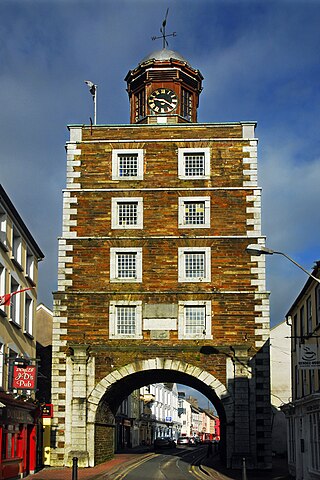
Youghal is a seaside resort town in County Cork, Ireland. Located on the estuary of the River Blackwater, the town is a former military and economic centre. Located on the edge of a steep riverbank, the town has a long and narrow layout. As of the 2022 census, the population was 8,564.

Carrigaline is a town and civil parish in County Cork, Ireland, situated on the River Owenabue. Located about 14 kilometres (8.7 mi) south of Cork city, and with a population of 18,239 people, it is one of the largest commuter towns of the city. The R611 regional road passes through the town, and it is just off the N28 national primary route to Ringaskiddy. Carrigaline grew rapidly in the late 20th century, from a village of a few hundred people into a thriving commuter town although some locals still refer to it as "the village". The town is one of the key gateways to west Cork, especially for those who arrive by ferry from France. Carrigaline is within the Cork South-Central Dáil constituency.

Ovens, formerly also Athnowen, is a small village adjacent to the town of Ballincollig, County Cork, Ireland. The 2006 census recorded that the population of the village was 1,703 - an increase of 62.1% from the 2002 Census. Ovens is within the Cork North-West Dáil constituency.

Ardmore is a seaside resort and fishing village in County Waterford, Ireland, not far from Youghal on the south coast of Ireland. It has a permanent population of around 430, that increases in the tourist season. It is believed to be the oldest Christian settlement in Ireland. According to tradition, Saint Declan lived in the region in the early 5th century, and Christianised the area before the coming of Saint Patrick.
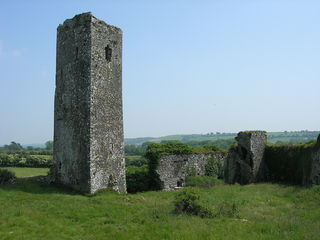
Ballincollig is a suburban town within the administrative area of Cork city in Ireland. It is located on the western side of Cork city, beside the River Lee on the R608 regional road. In 2016 it was the largest town in County Cork, at which time the Ballincollig Electoral Division had a population of 18,621 people. It is located beyond the green belt from the suburbs of Bishopstown and Wilton. Historically home to the Ballincollig Royal Gunpowder Mills which is now a Regional Park, the town has seen much growth in recent years as a satellite of Cork City. Ballincollig is within the Cork North-West Dáil constituency.

Ringaskiddy is a village in County Cork, Ireland. It is located on the western side of Cork Harbour, south of Cobh, and is 15 kilometres (9 mi) from Cork city, to which it is connected by the N28 road. The village is a port with passenger ferry, with two bi-weekly sailings to Roscoff in France. A ferry service to Swansea in Wales closed in 2012.
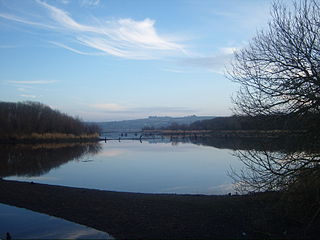
The River Lee is a river in Ireland. It rises in the Shehy Mountains on the western border of County Cork and flows eastwards through Cork, where it splits in two for a short distance, creating an island on which Cork's city centre is built, then passing through Cork Harbour on the south coast, one of the largest natural harbours in the world, to empty into the Celtic Sea. The catchment area of the River Lee is 1,253 km2. The long-term average flow rate of the River Lee is 40.4 cubic metres per second (m3/s)

Douglas is a suburb, with a village core, in Cork city, Ireland. Douglas is also the name of the townland, Roman Catholic parish, Church of Ireland parish and civil parish in which it is contained.

Bishopstown is located in the civil parish of St. Finbar's, Barony of Cork, County Cork, Ireland. It is a southwestern suburb of Cork and is made-up of the townlands of Ballineaspigbeg and Ballineaspigmore. It is near the town of Ballincollig, a satellite of Cork City, and is home to a number of schools and colleges,

Ballincollig Castle is a Norman castle to the south of the town of Ballincollig, County Cork, Ireland built after the Norman invasion of Ireland. In its prime, the castle was inhabited by the Barrett family, who had control of the local area. The castle still stands today, albeit largely in ruin. The original keep still remains, as does most of the curtain wall and two towers.
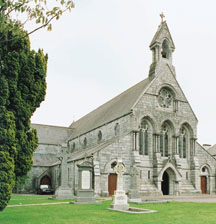
The Church of St Mary and St John is the older of two Roman Catholic churches in the town of Ballincollig, County Cork, Ireland. The church was built in the 1860s, funded by donations from the local people of the time, and officially opened on 28 October 1866. The church is in a Gothic Revival style, combined with some features of other periods. It is built of ashlar limestone with roof slates.

Sir Thomas Tobin was a British merchant. He moved to Ballincollig in 1863 to become managing director of Ballincollig Royal Gunpowder Mills. He played an active part in the social and industrial life of Ballincollig and Cork until his death in 1881.

The Ballincollig Royal Gunpowder Mills was one of three Royal gunpowder mills that manufactured gunpowder for the British Government. Located in Ballincollig, Cork city, Ireland, largely in what is now the Ballincollig Regional Park, the powder mills were originally opened in 1794 as a private enterprise, before being taken over by the British Government during the Napoleonic Wars.

Dripsey is a village in County Cork on the R618 regional road around 20 km (12 mi) west of Cork City. It is situated on a tributary of the River Lee, the Dripsey River. It is in the Catholic parish of Inniscarra. The Dripsey area hosts a water treatment plant, the Cork offices of the Environmental Protection Agency, and an award-winning garden center. The village has one pub, a primary school and a pre-school.

Ballinora or Ballynora is a small rural parish and townland near Cork city and Ballincollig in County Cork, Ireland. The townland is home to several education facilities and sporting clubs, and includes the village of Waterfall.
The Cork gunpowder explosion was a large explosion that took place in Cork, Ireland on 3 November 1810.

Wellington Road is a road on the north-side of Cork city. Wellington Road stretches almost a kilometre from St. Patricks Place, to St. Lukes Cross at the eastern end of the road.

Carrigrohane is a village and civil parish situated on the south bank of the River Lee to the west of the city of Cork in Ireland. It is connected by the Carrigrohane Straight, 4 miles (6.4 km) west of Cork and is also in the northeastern part of Ballincollig. It contains St Peter's Church of the Resurrection. In 1837, it had a population of 1921 inhabitants. The civil parish is almost evenly split between the baronies of Muskerry East to the west and the Barony of Cork to the east.
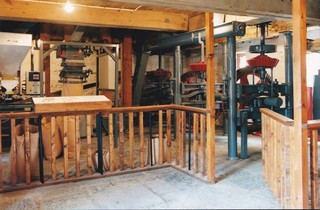
Cavan Water Mill, formerly Lifeforce Mill, is a 19th-century mill located in Cavan. The current building dates from 1846 and contains a notable MacAdam water turbine. Having been abandoned in the 1960s, it was restored as a museum and visitor attraction in the 1990s.

Catherine Tobin was a Victorian era author and artist who travelled with her husband and wrote books around the experiences as well as a translator for a book on the area.
References
- 1 2 3 "Ballincollig Gunpowder Trails" (PDF). corkcoco.ie. Cork County Council. 2017. Retrieved 11 December 2018.
- 1 2 3 "Ode to Ballincollig Royal Gunpowder Mills". corkheritage.ie. Kieran McCarthy. Retrieved 12 December 2018.
- 1 2 "Talbot buys Oriel House for €8m". Irish Examiner. 3 May 2014. Retrieved 11 December 2018.
- ↑ McCarthy, Donagh (1988–1989). "Times Past: Journal of the Ballincollig Community School Local Historical Society; Volume 5" (PDF). Retrieved 28 June 2021.
- 1 2 "Oriel House, Ballincollig, County Cork". buildingsofireland.ie. National Inventory of Architectural Heritage. Retrieved 11 December 2018.
- 1 2 "Tobin (Ballincollig) – Oriel House". Landed Estates Database. NUI Galway. Retrieved 11 December 2018.
- ↑ "History of the Tidy Towns Competition". ballincolligtidytowns.ie. Ballincollig Tidy Towns Committee. Retrieved 12 December 2018.
Oriel House [is] An early nineteenth century Georgian building, originally built as three houses for the administrating officers at the gunpowder mills. Later the home of Sir Thomas Tobin, it acquired the name Oriel Court after the Oriel window he added to the east wing of the house to bring brightness and light into the upper room where his wife used to paint
- ↑ "Gunning for Ballincollig". corkindependent.com. Cork Independent. 27 July 2017. Retrieved 12 December 2018.
- ↑ "Co Cork hotel on market for €6m". Irish Examiner. 30 January 2013. Retrieved 12 December 2018.